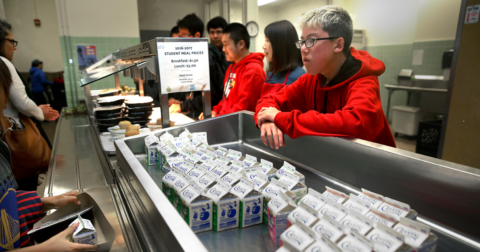News
The Trump Administration Wants to Gut The Clean Water Act
Policy•8 min read
News
Students currently need a doctor’s note to require a school to provide non-dairy milk. A new bill would change that.


Words by Seth Millstein
In early June, Congress advanced legislation that would expand access to plant-based milks in public schools. The Whole Milk For Healthy Kids Act cleared committee votes in both chambers of Congress, and is primarily aimed at allowing schools to serve more varieties of dairy milk. However, it would also lift some restrictions on serving non-dairy milks in schools as well.
The National School Lunch program currently requires participating schools to serve dairy milk in order to be reimbursed by the federal government, and schools are only required to make non-dairy milks available to a student if the student obtains a doctor’s note attesting to a disability or other special dietary need. Parents or guardians can provide a note, but schools are not obligated to provide a substitution in those cases. If the Whole Milk for Healthy Kids Act passes, however, students will only need a note from a parent to trigger this requirement.
The Senate version of the bill would take things one step further. Under current law, schools aren’t allowed to make nondairy milk available to all students as a general menu offering. But an amendment added to the bill shortly before its committee approval would eliminate this prohibition, and allow schools to voluntarily make non-dairy milks available to all students.
“This amendment is a really meaningful step forward,” Meghan Jones, Senior Policy Advocate for School Food Policy at Friends of the Earth, tells Sentient. “It puts decision making back into the hands of parents. But ultimately, non-dairy alternatives should be offered just like dairy milk. We shouldn’t be requiring notes of any kind. It should just be up to student choice.”
Neither version of the bill has yet been scheduled for a full vote. While it’s too soon to say whether or not it will pass, it’s notable that both versions of the bill have drawn significant bipartisan support thus far — a rarity in today’s divided Congress.
But all of this prompts the question: Why are school lunches required to have dairy in the first place?
Since its passage in 1946, the National School Lunch Program has provided free or low-cost lunches to public school children. In order to be reimbursed for these meals, however, schools must abide by certain requirements, one being that they serve dairy milk with every meal.
In 2010, Congress passed legislation that effectively banned schools from serving whole or two percent milk as part of their lunch programs. The Whole Milk For Healthy Kids Act originated as an attempt to reverse this prohibition, and clear the way for schools to serve more varieties of dairy milk.
The bill was originally introduced in 2023, and it would have strictly addressed whole and two percent dairy milk. That version didn’t pass, but lawmakers reintroduced the legislation in 2025, and in it, they included a provision that would lift the doctor’s note requirement for non-dairy milks.
On June 3rd, the Senate Committee on Agriculture, Nutrition, and Forestry voted to advance the amended bill. Two days later, the House Committee on Education and Workforce did the same. Both are now eligible for a full floor vote in their respective chambers, though no vote has been scheduled for either yet.
It’s worth noting that not all milk replacements will be eligible for reimbursement under the new bill. Thanks to separate provisions of the National School Lunch Program, any non-dairy milks served as part of the program must meet specific nutritional requirements, which are outlined in detail by the USDA and primarily concern the calcium, protein, vitamins and other nutrient content of the milk replacement in question.
You might assume that the National School Lunch Program requires dairy milk to be served because of dairy milk’s nutritional value. But that’s only half of the story.
The law that created the program stated two goals for doing so: One is to “safeguard the health and well-being of the Nation’s children,” but the other is to “encourage the domestic consumption of nutritious agricultural commodities.” The dairy milk requirement was added to the school lunch law in large part to support the U.S. dairy industry, something the U.S. government is very committed to doing through a number of federal programs.
“When you look at quotes from legislators that have supported and introduced the bill, they even mentioned that it’s, in part, to support the dairy industry,” Jones notes. In his initial press release on the bill, for instance, House Agriculture Committee Chair Glenn Thompson said the legislation will help “America’s hard-working dairy farmers.”
In that same press release, Thompson and other legislators repeated common claims attesting to dairy milk’s nutritional value. Despite milk’s reputation as a nutritious food, around 65 percent of people in the world are lactose intolerant.
Indigenous, Black and Asian people face even higher rates of lactose intolerance; by contrast, only 15 percent of Caucasian people can’t properly digest lactose in the U.S. This means that the existing law’s requirements for obtaining non-dairy milks falls disproportionately on the shoulders of non-Caucasian students, Jones says.
“A lot of the students that are relying on the school lunch program are students of color who might also have higher rates of lactose intolerance,” Jones says. “Placing these unnecessary burdens on them accessing products that have the same nutrients but won’t make them sick starts to be quite complex.”
As such, the bill would make it easier for students to access non-dairy milk for health reasons. But health reasons aren’t the only reason students might not want cow’s milk on their lunch tray.
Although the production of dairy milk doesn’t require any animals to be slaughtered, it does subject them to an enormous amount of physical pain. At least, that’s the case on industrialized dairy farms, where bulls are subject to a practice known as electroejaculation in order to ensure a constant stream of pregnant, lactating cows.
Some students object to dairy milk on the grounds that they don’t want to support these practices. For others, it’s a question of environmental preservation.
Like all types of animal farms, dairy farms emit greenhouse gasses, pollute the air and water, contribute to habitat destruction, and require significant land and water use. While plant-based milk replacements vary in their environmental impacts, all have far less impact than dairy milk.
All of this is a long way of saying that there are many reasons students might prefer non-dairy milk to cow’s milk. If the Whole Milk For Healthy Kids Act passes, they’ll have an easier time accessing those alternatives.
Ultimately, the dairy industry is deeply entrenched in U.S. policy. From school lunches to the various dairy checkoff programs, the federal government does a lot to ensure that Americans consume as much cow’s milk as possible, despite the health, environmental and animal welfare issues it poses.
The proposed legislation would only address one component of this entrenchment, and only to a limited extent. Still, the new language does represent some progress for those who want to see more access to dairy alternatives. If the Whole Milk For Healthy Kids Act becomes law, students across the country will no longer need a doctor’s note to be served healthy, plant-based and more environmentally-friendly milk alternatives at school.